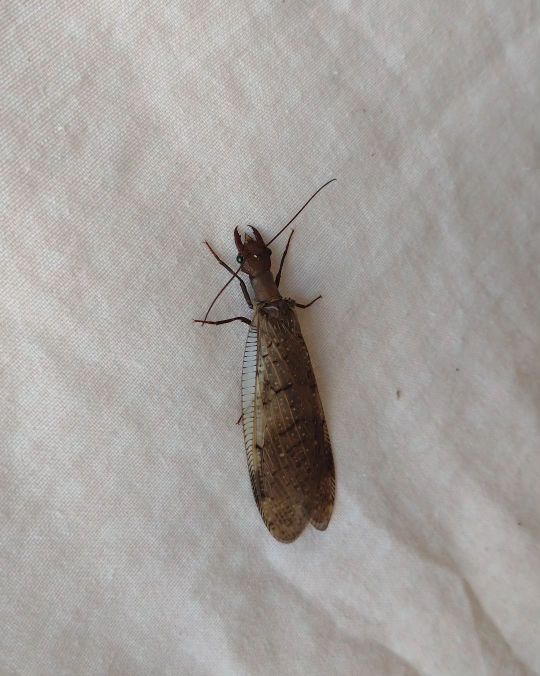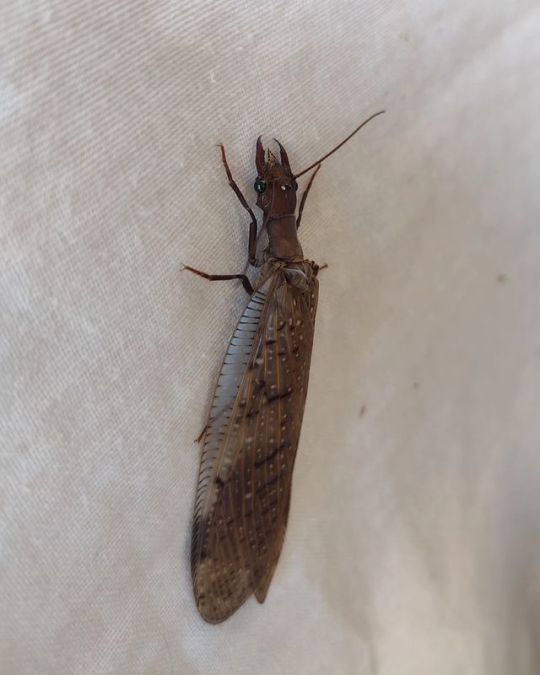#Corydalus
Text
Bug of the Day

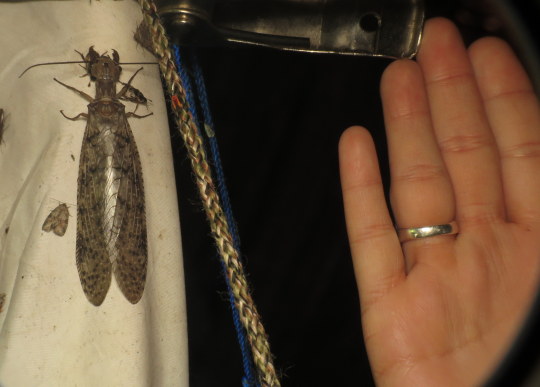
Ok, there were lots of votes for fuzzy (tomorrow, I promise), but I was inspired by @cccshutdown requesting "bring me the Longest beast you know" to post this ginormous female dobsonfly we found at the lights a couple of weeks ago. She is Eastern Dobsonfly (Corydalus cornutus), she is Megaloptera, and she is FIERCE!!
#Eastern dobsonfly#Corydalus cornutus#Corydalus#Corydalidae#dobsonfly#Megaloptera#insect#FIERCE#bug of the day#BotD
541 notes
·
View notes
Text

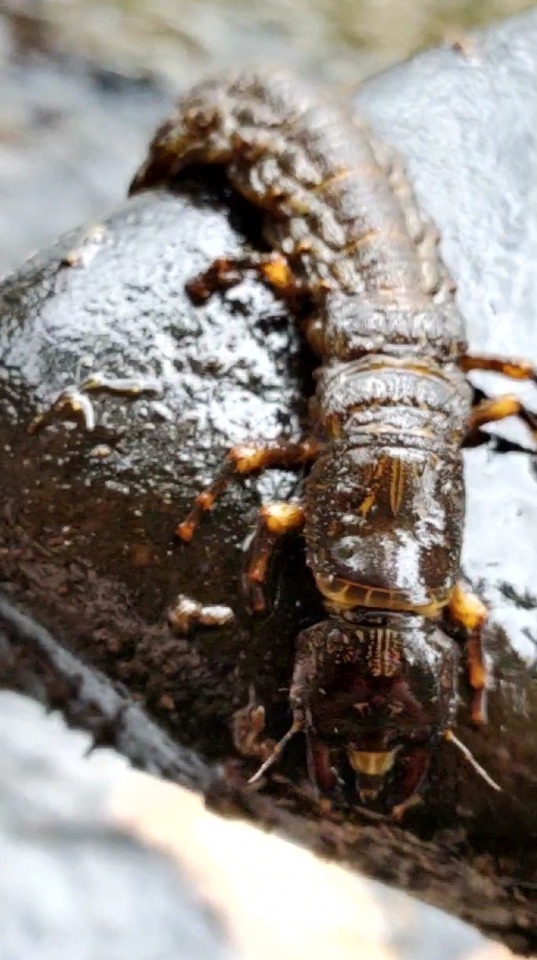
Eastern dobsonfly (Corydalus cornutus) larva I found while hanging out in the river in Northeastern Pennsylvania (US) last year.
Dobsonfly larvae, also known as hellgrammites, are one of the top invertebrate predators in fast-moving streams. They tend to hide under rocks and use their sharp mandibles to capture and eat prey. These mandibles can also deliver a painful (but harmless) bite, so definitely be careful handling them!
Larvae can get up to 3.5 inches (9 cm) long. Since they're large and relatively common, many of the local fishermen like to use them as bait (which may or may not be problematic).
These insects spend 1-3 years as larvae and pupate outside of the stream under a rock or log. The adults are huge. The male can be up to 5.5 inches (14 cm) long and has massive mandibles that are intimidating but harmless. Adults aren't known to feed, and they only live for about a week, just enough time to mate and lay eggs.
#dobsonfly#dobsonfly larva#hellgrammite#bug#Corydalus cornutus#Corydalidae#Megaloptera#eastern dobsonfly#nature#bugs#biodiversity#animals#inaturalist#arthropods#bugblr#entomology#insect appreciation#creature#invertebrates#aquatic life#pennsylvania#river#predator#nature appreciation#cool facts#biology#science#interesting
18 notes
·
View notes
Text
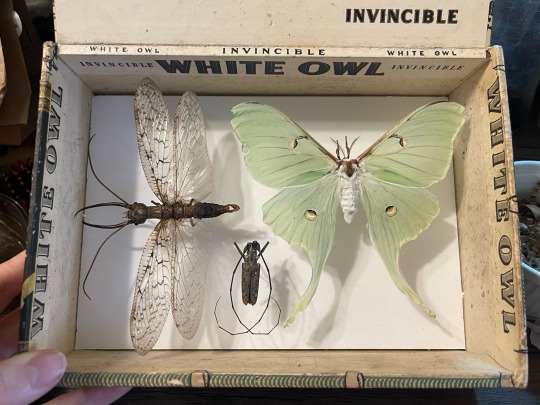
recent pins. still reconstructing the longhorn, he needs some legs glued on.
Eastern Dobsonfly, Corydalus cornutus
Northeastern Pine Sawyer, Monochamus notatus
Luna Moth, Actias luna
37 notes
·
View notes
Text
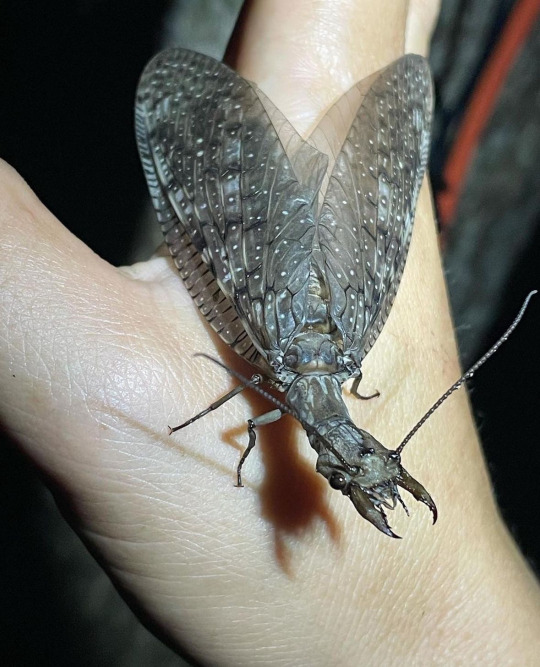
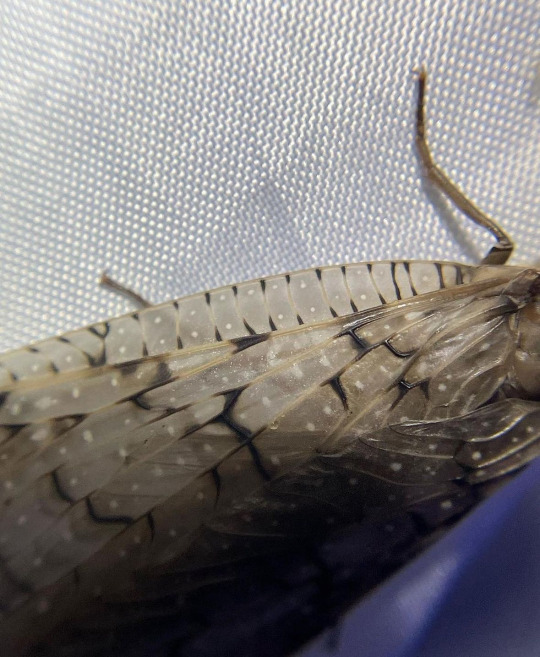
Nocturnal flying Dobson flies
These creatures at their larval stage is an aggressive aquatic predator that can eat fish. Also known as toebitter and hellgrammite this single species has two common names, corydalus cornutus, depending on its lifecycle stage.
7 notes
·
View notes
Note
what is your favorite aquatic invertibrate?
THIS is a loaded question. I've kept this in my inbox for a while cause there's SO MANY it's hard to choose. I'm most interested in mollusca and crustacea but those are still large categories.
My favorite mollusk is Dirona albolineata, the frosted alabaster nudibranch. Absolutely gorgeous and come in my favorite color.
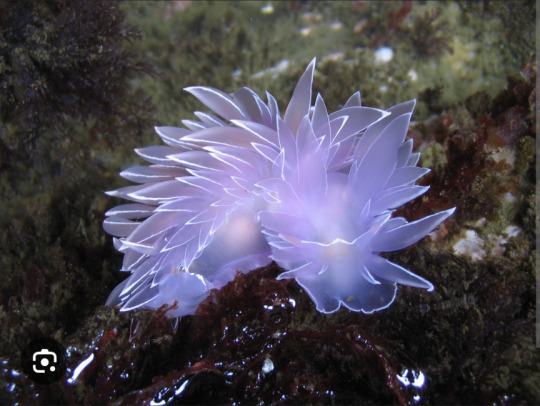
I pretty much love all nudibranches though. My second favorite would have to be sea butterflies, they're so weird!

And of course the animal crossing famous Clione limacina or sea angel
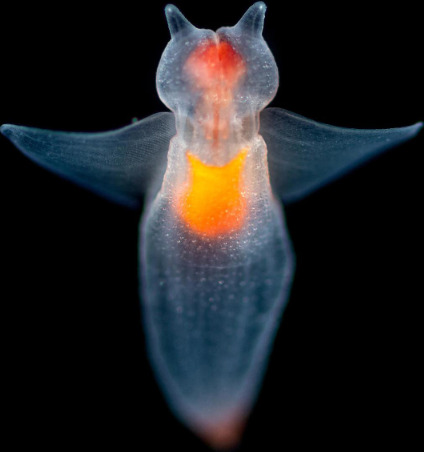
Academically, I'm currently researching freshwater mussels for our reintroduction project. Mussels may not be as flashy as nudibranchs, but they are extremely important for improving water quality in freshwater habitats. It's hard to choose a favorite, but one I've researched the most and have grown fondly of is Alasmidonta varicosa, the brook floater. We are hoping to eventually reintroduce it to it's previous native range. Fun fact, when you pick them up out of the water, they stick their "tongue" (foot) out.
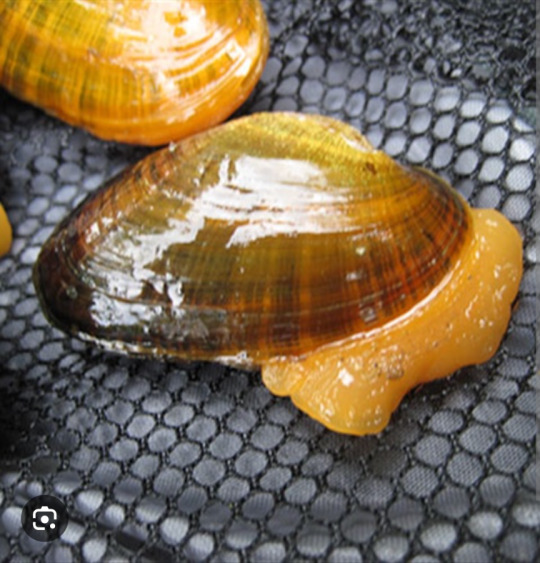
I literally had the species name written on my giant whiteboard in the office for a few months so my boss would keep seeing it since I really wanted us to use it as a flagship species to design our reintroduction project around. Fast forward and we've gotten a grant and things are progressing nicely.
Anyway on the crustacea side that's an even harder choice. I'm always excited to see aquatic isopods and scuds. I'm probably most fond of Malacostraca (amphipods, isopods, decapods, etc.) and Branchiopoda (clam, fairy, and tadpole shrimp, and water fleas). Do not make me pick one I am unable to. I will say I have a particular soft spot for crayfish as they are the organisms I've had the most one-on-one time with (I literally have a pet crayfish named Mr Pinchy). I just love anything with pinchers (ʃƪ^3^)≧〔゜゜〕≦

First crayfish I ever held doing it's little defensive stance of Shake Em Like You Just Don't Care. Just take a look at it's mouth! The mouthparts are so cool! I love watching Mr. Pinchy eat.
My favorite macroinvertebrate would hands down be Corydalus, aka Hellgrammites, which are the larval form of Dobsonflies. I have yet to see an adult dobsonfly in person, but have been told they're terrifying and not very nice. We shall see about that. Hellgrammites are simply angry pathetic overdramatic babies and while people say they bite I've held plenty and never been bit. They will absolutely go for the other bugs in the tray so you do have to keep them in a separate container. We've lost a couple of caddisfly larvae to the jaws of the mighty hellgrammite.
Just look at it! Here's a video where I'm trying to get a good shot of it's gills (those frilly things on its underside). They roll into a defensive ball which is so endearing. I also love anything that can curl into a ball. I think they're absolutely adorable but most people tend to disagree with me ಥ‿ಥ
TDLR I love all aquatic invertebrates so very much. I didn't even get into shrimp or coral or starfish! They make me so happy I actually have to limit how much I read about them in a day because my emotions get too big and cause me to become hyper (which is a bad combo for fibromyalgia). I'm not great at remembering information so I get to constantly relearn and rediscover things which is a blessing and a curse. This also makes taxonomy especially hard for me so let me know if I messed up somewhere.
10 notes
·
View notes
Text
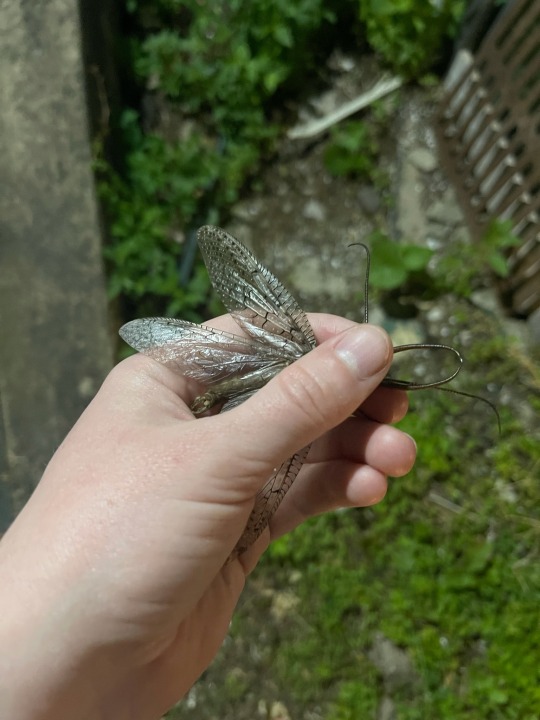


first bigman of the year, was loitering outside my front door
Corydalus cornutus
169 notes
·
View notes
Text
December 13th, 2023

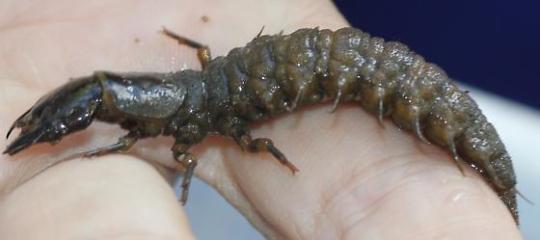
Eastern Dobsonfly (Corydalus cornutus)
Distribution: Found throughout eastern North America, from Canada down to Mexico.
Habitat: Found in or near fast-flowing, unpolluted rivers and streams; larvae live on the stream bottom, while adults are terrestrial (though remain around bodies of water).
Diet: Larvae are active predators, feeding on small invertebrates such as insects, other arthropods, molluscs and worms; preference for the larvae of blackflies, caddisflies and mayflies. Adult females feed on nectar, while males are not known to feed.
Description: Eastern dobsonflies are large, solitary insects. Their most obvious characteristic is the males' oversized mandibles, which can reach up to half the length of its body. Despite the adults' fearsome appearance, however, they're quite harmless. Larvae, however, have powerful mandibles and the capacity to deliver a painful bite.
Dobsonfly larvae, also known as hellgrammites, are commonly used as bait for fishermen. They're important predators of invertebrates in stream ecosystems, and are a natural enemy of blackflies. In habitats where fish are small or absent, large hellgrammites may be the largest predator in the water.
(Images by Kailyn Lianne Liu (adult) and Even Dankowicz (larva))
8 notes
·
View notes
Text
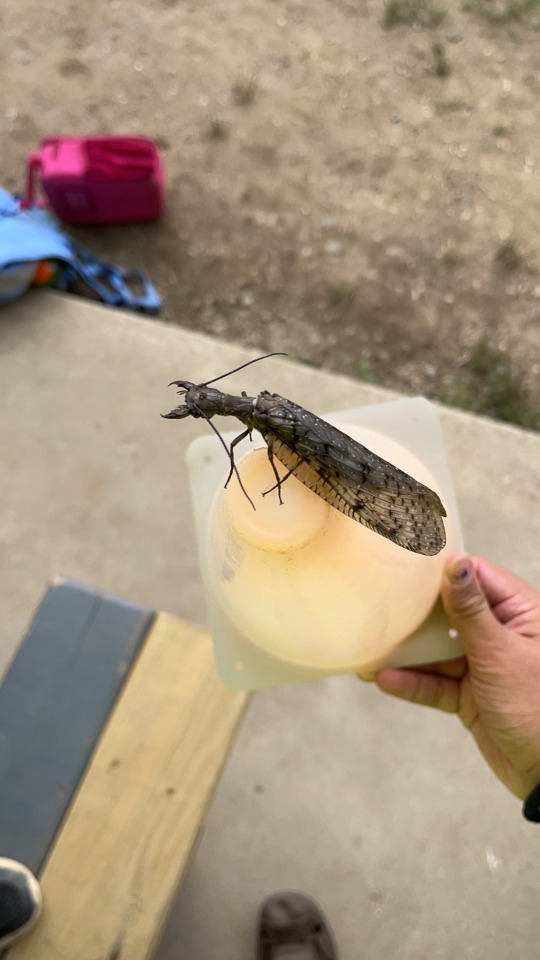
Big-ass bug I found at work today.
A female Eastern Dobsonfly (corydalus cornutus)
Thought it was cool. Crazy to think that it’ll only be alive for like a week or two before mating then dying. Sometimes I envy them…
12 notes
·
View notes
Photo


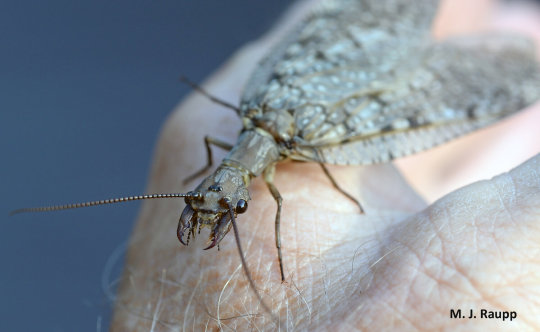
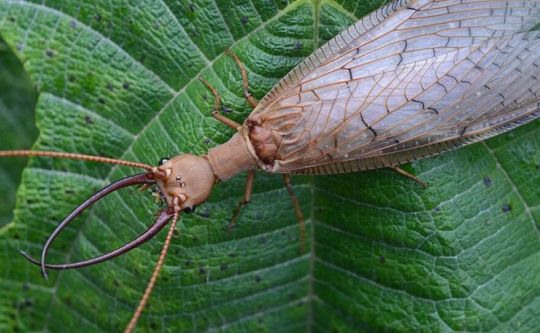
Darling Eastern Dobsonflies
requested by @skyroller
Eastern dobsonflies (Corydalus cornutus) is a distinct species of insect commonly found in the eastern rivers of North America. They go through several stages over the course of their lives, which in total can last as long as three years. They begin as eggs, laid close to water in clusters of up to 1,000. These clusters often resemble bird droppings as a form of camouflage. About a week or two after being laid, the eggs hatch into the form they spend most of their lives in-- the larvae known as hellgrammites.
Hellgrammites are aquatic, spending most of their time under river rocks. Over the course of 1-3 years, these larvae can molt up to 12 times. In late spring or early summer they finally emerge from the water, burrow into the soft soil of the river’s edge, and pupate. In colder regions C. cornutus remains dormant throughout the winter, but in warmer regions adults emerge after only 1-2 weeks. Male adults use their powerful jaws to fight each other for access to females, and after successfully mating both males and females die.
Larval C. cornutus have dark brown or black segmented bodies with 3 pairs of legs. Protruding from each segment is a filament with a gill tuft at the base, which they use to breathe under water. In addition to these, hellgrammites have a set of external respiratory openings called spiracles, with which they can also breathe on land. Adult dobsonflies look significantly different. The abdomen, while still segmented, is lightened to a tan and becomes more elongated; in total they can be up to 14cm long. The filaments are gone, replaced with 2 sets of large wings, which reach spans of 13cm. Adults also have a pair of antennae, which they can use to locate the chemical signals emitted by potential mates. Male C. cornutus sport a large, curved set of mandibles, which make up almost half their body length.
Because adult dobsonflies die soon after mating, they don’t eat. Hellgrammites, however, consume a wide range of smaller insects and larvae, mollusks, and crustaceans, making them important low-level predators in their native rivers. Both larvae and adults host a large number of predators including fish, crayfish, birds, and bats. Hellgrammites are also a popular choice of bait for fishermen. To protect themselves from predators, larvae and adults have mandibles that can deliver a powerful bite. They are also active primarily at night to avoid diurnal predators.
Conservation status: The eastern dobsonfly has not been evaluated by the IUCN. However, over collection for fishing may deplete populations, and larval dobsonflies are vulnerable to river pollution and deplition.
Photos
Jim Rathert
Isaac Szabo
Michael Raupp
Geoff Gallice
#eastern dobsonfly#Megaloptera#Corydalidae#dobsonflies#insects#arthropods#freshwater fauna#freshwater arthropods#rivers#river arthropods#deciduous forests#deciduous forest arthropods#North America#eastern north america#animal facts#biology#zoology#requested
66 notes
·
View notes
Text
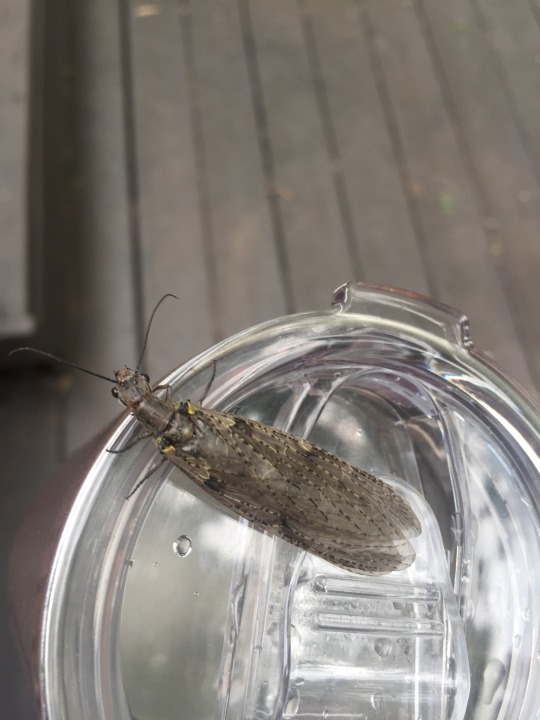

@speedydragondiplomatalien No ID needed for my little gal pal. She’s an eastern dobsonfly (Corydalus cornutus), she’s quite small for what I’ve seen and very friendly as well! Haven’t seen a male yet but I hope to very soon! Sending love bugs from the Midwest! 🐝🐌🦋
She’s beautiful! But she’s not a dobsonfly, she’s a fishfly in the genus Chauliodes. Female dobsonflies have larger mandibles than female fishflies do, and of course male dobsonflies have the biggest mandibles of all! Male fishflies are distinguishable by their large, feathery antennae.
Here’s a female eastern dobsonfly for comparison! Note the large mandibles and the lack of yellow spots on the “shoulders” like yours has :)
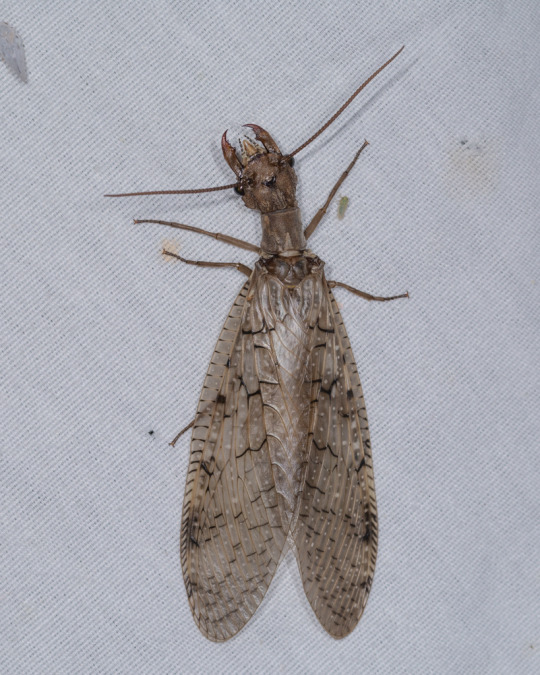
Photo by tfandre
96 notes
·
View notes
Text




Dobsonfly in the Andean rainforest of northern Peru. Is it a Corydalus sp.?
#faunaofperu #peruvianinsect #dobsonfly
4 notes
·
View notes
Text
MOSCA DOBSON DEL ESTE ( CORYDALUS CORNUTUS, LINNEO 1758 )
LARVA_CORYDALUS CORNUTUS
CORYDALUS CORNUTUS
ORDEN: MEGALOPTERA.
FAMILIA: CORYDALIDAE.
AMBIENTE: ACUÁTICO- TERRESTRE.
ACTIVIDAD: NOCTURNO CREPUSCULAR.
ALIMENTACIÓN: PREDADOR LARVA.
METAMORFOSIS: HOLOMETÁBOLO.
DISTRIBUCIÓN, HÁBITAT: ESTA ESPECIE SE ENCUENTRA EN TODO EL CONTINENTE AMERICANO DESDE EL ESTE DE LOS ESTADOS UNIDOS. HABITA RÍOS Y ARROYOS TANTO EN ZONAS BAJAS COMO DE MONTAÑA, EN ZONAS…

View On WordPress
0 notes
Text
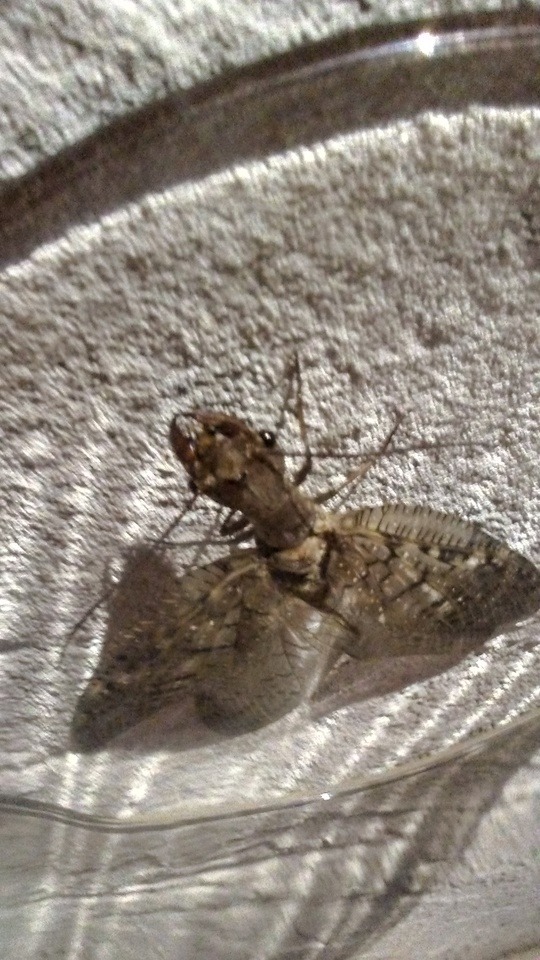
@glumshoe I met a very intimidating bug tonight at work! Apparently this is a corydalus or dobsonfly and I think a female at that? From what I looked up, males have scary long mandables!
Just thought you might find it interesting!
2 notes
·
View notes
Text
They need to make more bug plushies. I want to hold and cuddle my bugs but cannot bc they are fragile and do not like that. Give me a Corydalus cornutus larva that I can snuggle without it biting the absolute hell out of me (haha get it)
#bugblr#invertebrates#entomology#biology#insects#bonus points if its artculated and can roll up into a ball
10 notes
·
View notes
Photo
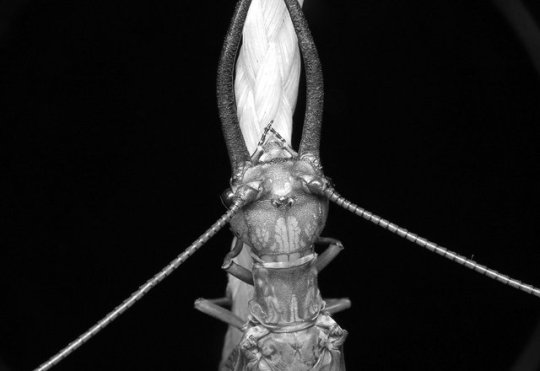
Bug of the Day
I was participating in that silly black & white photo meme on Facebook and came up with this dobsonfly gem. I loved it so much, I had to post it here! It reminds me of a Janet Jackson video for some reason...
#dobsonfly#Eastern Dobsonfly#Corydalus cornutus#Corydalus#Corydalidae#Megaloptera#insect#black and white#missjacksonifyourenasty
82 notes
·
View notes
